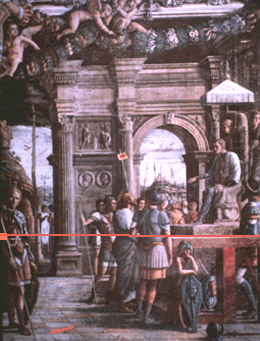Finding the correct viewing position
Step 2: Finding the Viewing Distance

- Locate the vanishing point of the orthogonals, if there are any (that is, find the primary vanishing point).
 In this image, the edges of the tile floor appear to be parallel to each other, and so in real life they would be parallel to the picture plane. Since we expect tiles to be square, we can assume that the other edges of the tile floor are orthogonals.
Therefore, we should place our eye opposite the primary vanishing point.
In this image, the edges of the tile floor appear to be parallel to each other, and so in real life they would be parallel to the picture plane. Since we expect tiles to be square, we can assume that the other edges of the tile floor are orthogonals.
Therefore, we should place our eye opposite the primary vanishing point.
- Are there any squares that are parallel to the "floor" or the "side wall"? If not, time to move on to some other plan.
In this picture, the tiles are clearly square parallel to the floor.
- We're going to be looking for the vanishing point of a diagonal of the square.
- Draw the diagonal of the square. If the square is parallel to the "floor", the diagonal's vanishing point is going to be on the horizon line -- the horizontal line through the primary vanishing point. In preparation for finding this vanishing point, draw in the horizon line.
 (If the square is parallel to the "side wall", the diagonal's vanishing point is going to be on the "verizon" line -- the vertical line through the primary vanishing point. In preparation for finding this vanishing point, draw in the verizon line.)
(If the square is parallel to the "side wall", the diagonal's vanishing point is going to be on the "verizon" line -- the vertical line through the primary vanishing point. In preparation for finding this vanishing point, draw in the verizon line.)
- Extend the diagonal until it intersects either the horizon line or the "verizon" line, depending on whether your square is parallel to the floor or the side wall. This gives you the vanishing point of the diagonal. We will call that the secondary vanishing point.

- The distance between the primary and secondary vanishing points will be the viewing distance.
Conclusion: Place your eye directly opposite the primary vanishing point; it should be the same distance back from it as the distance between the two vanishing points away.
Next - Why does this work?
Back to perspective | Back to Inclass




